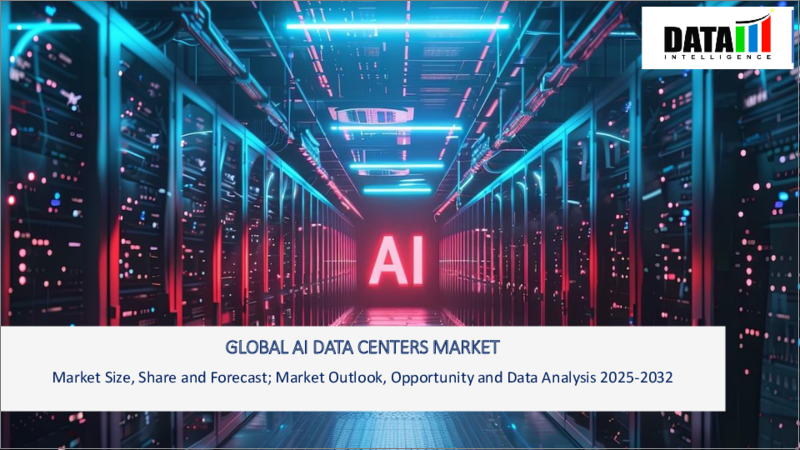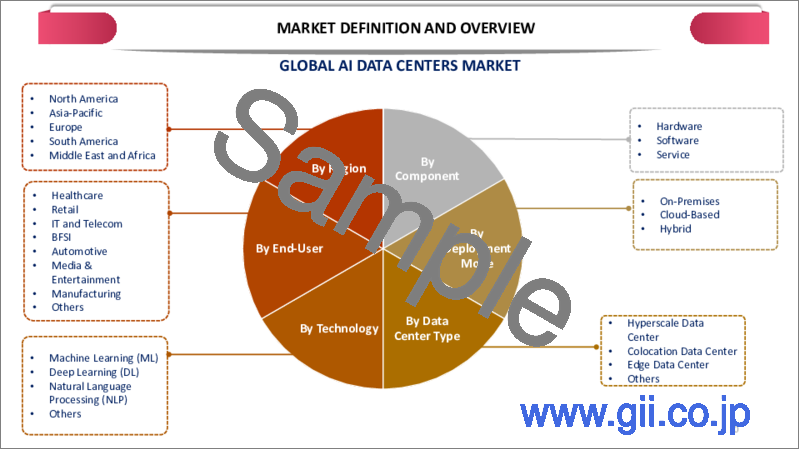|
|
市場調査レポート
商品コード
1654693
AIデータセンターの世界市場:2025年~2032年Global AI Data Centers Market - 2025-2032 |
||||||
カスタマイズ可能
適宜更新あり
|
|||||||
| AIデータセンターの世界市場:2025年~2032年 |
|
出版日: 2025年02月13日
発行: DataM Intelligence
ページ情報: 英文 205 Pages
納期: 即日から翌営業日
|
- 全表示
- 概要
- 目次
AIデータセンターの世界市場は、2024年に136億7,000万米ドルに達し、2032年までには789億1,000万米ドルに達すると予測され、予測期間中の2025年から2032年のCAGRは24.50%で成長します。
世界のAIデータセンター市場は、AIアプリケーションをサポートするための計算能力に対する需要の増加により、著しい成長を遂げています。これらのセンターは、機械学習、自然言語処理、コンピュータ・ビジョンの進歩を可能にするために極めて重要です。政府も企業も、効率と競争力を向上させるため、AI主導のインフラに多額の投資を行っています。
国際エネルギー機関(IEA)によると、2022年の世界のデータセンターの電力需要は460テラワット時(TWh)に迫り、AIに特化したワークロードは2030年までにエネルギー消費を大幅に増加させると予測されています。エッジAIコンピューティングは、データソースにより近いリアルタイム分析を可能にすることで、データセンター市場に革命をもたらしています。この動向は待ち時間を短縮し、プライバシーを強化するため、自律走行車やスマートシティアプリケーションに最適です。
アジア太平洋は、AIインフラへの多額の投資と政府の支援策により、AIデータセンターの急成長市場としてリードしています。中国、インド、日本などの国々は、技術革新を推進するためにAI戦略を進めています。中国の工業情報化部(MIIT)は、初期資本82億米ドルの新しい人工知能(AI)投資ファンドを設立しました。さらにインドでは、2025年までに5,000億米ドルが経済に貢献する可能性があり、AIは農業、ヘルスケア、都市計画、製造業などの主要セクターに革命を起こす立場にあります。
ダイナミクス
データとAIアプリケーションの飛躍的成長
デジタルデータの爆発的な増加は、AIデータセンターの成長を促す主要な要因です。2023年に生成された120ゼタバイトは、2025年には150%以上増加し、181ゼタバイトに達すると予想されています。ヘルスケア、自動車、小売を含む業界全体でAIが急速に採用されているため、膨大なデータセットを管理し、複雑な計算を実行できる堅牢なデータセンター・インフラが必要とされています。
IBMのWatsonのようなヘルスケアにおけるAIアプリケーションは、診断や個別化医療のために広範なリアルタイムデータ処理を必要とします。同様に、Teslaのような企業の自律走行車も、AIモデルの訓練とリアルタイムの意思決定のためにデータセンターに依存しています。貿易・商取引のデジタル変革も、eコマース取引、物流、顧客インサイトを処理するための大容量AIデータセンターの必要性を高めています。
政府の取り組みとAIインフラへの投資
世界各国の政府はAIエコシステムの開発を優先しており、高度なデータセンターへの需要を直接煽っています。例えば、欧州委員会は、最先端のAIおよび量子テクノロジー・プロジェクトに1億1,600万米ドルを超える多額の資金を提供する、新たなHorizon Europe callsの開始を発表しました。一方、米国政府は2025年1月、人工知能のインフラ整備に5,000億米ドルを拠出すると発表し、国家的なAI野望の達成におけるデータセンターの重要性を強調しました。
新興国の政府も投資を強化しています。インドでは、政府が支援するAIイノベーション・ハブをティア2およびティア3の都市に設置し、地元の人材を育成し、データセンターを含むイノベーションを促進する必要があります。こうした取り組みは、AIを活用した経済開発に重点を置き、成長のための環境を整えつつあります。AIはデータセンターのエネルギー管理に変革をもたらし、予知保全や動的冷却システムによって運用コストとカーボンフットプリントを削減しています。
高いエネルギー消費と環境への懸念
AIデータセンターはエネルギー集約型であり、サーバーと冷却システムが消費電力の大部分を占めています。ガス輸出国フォーラム(GECF)によると、AIワークロードは2030年までに世界のデータセンターの電力需要の15%を占めるようになり、環境への懸念と規制の監視につながります。エネルギー使用は、直接的なコストにも影響します。
さらに、電力と冷却にかかる運用費は、データセンターの予算の60%から70%を占めることもあります。さらに、環境団体はカーボンニュートラル基準の厳格化を推進しており、既存施設の運用を複雑にしています。Googleがデンマークでカーボンニュートラル・データセンターに6億米ドルを投資したような実例は、エネルギー課題を軽減する努力を示していますが、持続可能性を達成するための財政的負担の大きさを浮き彫りにしています。
目次
第1章 調査手法と調査範囲
第2章 定義と概要
第3章 エグゼクティブサマリー
第4章 市場力学
- 影響要因
- 促進要因
- データとAIアプリケーションの急激な成長
- AIインフラに対する政府の取り組みと投資
- 抑制要因
- 高いエネルギー消費と環境問題
- 機会
- 影響分析
- 促進要因
第5章 産業分析
- ポーターのファイブフォース分析
- サプライチェーン分析
- 価格分析
- 規制分析
- 持続可能な分析
- DMIの見解
第6章 コンポーネント別
- ハードウェア
- プロセッサ
- ネットワーク機器
- ストレージ
- その他
- ソフトウェア
- AI/MLフレームワーク
- データ管理・オーケストレーションツール
- セキュリティツール
- その他
- サービス
- インストール・統合
- マネージドサービス
- コンサルティングサービス
第7章 展開モード別
- オンプレミス
- クラウドベース
- ハイブリッド
第8章 データセンタータイプ別
- ハイパースケールデータセンター
- コロケーションデータセンター
- エッジデータセンター
- その他
第9章 エンドユーザー別
- ヘルスケア
- 小売り
- IT・通信
- BFSI
- 自動車
- メディア・エンターテイメント
- 製造業
- その他
第10章 サスティナビリティ分析
- 環境分析
- 経済分析
- ガバナンス分析
第11章 地域別
- 北米
- 米国
- カナダ
- メキシコ
- 欧州
- ドイツ
- 英国
- フランス
- イタリア
- スペイン
- その他欧州地域
- 南米
- ブラジル
- アルゼンチン
- その他南米
- アジア太平洋
- 中国
- インド
- 日本
- オーストラリア
- その他アジア太平洋
- 中東・アフリカ
第12章 競合情勢
- 競合シナリオ
- 市況・シェア分析
- M&A分析
第13章 企業プロファイル
- Schneider Electric
- 会社概要
- 製品ポートフォリオと概要
- 財務概要
- 主な発展
- Amazon.com, Inc
- Microsoft
- IBM corp
- NVIDIA Corporation
- Cisco Systems, Inc
- Cadence Design Systems, Inc.
- Advanced Micro Devices, Inc.
- CyrusOne
- Juniper Networks, Inc.
第14章 付録
Global AI Data Centers Market reached US$ 13.67 billion in 2024 and is expected to reach US$ 78.91 billion by 2032, growing with a CAGR of 24.50% during the forecast period 2025-2032.
The global AI data centers market is witnessing remarkable growth, driven by the increasing demand for computational power to support AI applications. These centers are pivotal for enabling advancements in machine learning, natural language processing and computer vision. Governments and enterprises alike are investing heavily in AI-driven infrastructure to improve efficiency and competitiveness.
According to the International Energy Agency (IEA), the global data center electricity demand in 2022 was closer to 460 terawatt-hours (TWh) and AI-specific workloads are projected to increase energy consumption significantly by 2030. Edge AI computing is revolutionizing the data center market by enabling real-time analytics closer to the data source. This trend reduces latency and enhances privacy, making it ideal for autonomous vehicles and smart city applications.
Asia-Pacific leads as the fastest-growing market for AI data centers due to substantial investments in AI infrastructure and supportive government initiatives. Countries such as China, India and Japan are advancing AI strategies to drive technological innovation. The Ministry of Industry and Information Technology (MIIT) in China has created a new artificial intelligence (AI) investment fund, with an initial capital of US$ 8.2 billion. Additionally, In India, with the potential to contribute US$ 500 billion to the economy by 2025, AI stands to revolutionize key sectors such as agriculture, healthcare, urban planning and manufacturing.
Dynamics
Exponential Growth of Data and AI Applications
The explosion of digital data is a major driver for AI data center growth. The 120 zettabytes generated in 2023 are expected to increase by over 150% in 2025, hitting 181 zettabytes. The rapid adoption of AI across industries, including healthcare, automotive and retail, requires robust data center infrastructure capable of managing massive datasets and performing complex computations.
AI applications in healthcare, such as IBM's Watson, require extensive real-time data processing for diagnostics and personalized medicine. Similarly, autonomous vehicles from companies like Tesla depend on data centers for AI model training and real-time decision-making. Digital transformation in trade and commerce has also escalated the need for high-capacity AI data centers to process e-commerce transactions, logistics and customer insights.
Government Initiatives and Investments in AI Infrastructure
Governments globally are prioritizing the development of AI ecosystems, directly fueling demand for advanced data centers. For example, the European Commission has announced the launch of new Horizon Europe calls, with a substantial funding pool of over US$ 116 million in funding for cutting-edge AI and quantum technology projects. Meanwhile, In January 2025, the government of the US announced US$ 500 billion to fund infrastructure for artificial intelligence, emphasizing the importance of data centers in achieving national AI ambitions.
Governments in emerging economies are also stepping up investments. India's government-backed AI innovation hubs should be set up in tier-2 and tier-3 cities to nurture local talent and foster innovation, which include data centers. Such initiatives are creating an environment ripe for growth, with an emphasis on AI-powered economic development. AI is transforming the energy management of data centers, with predictive maintenance and dynamic cooling systems reducing operational costs and carbon footprints.
High Energy Consumption and Environmental Concerns
AI data centers are energy-intensive, with servers and cooling systems accounting for a significant portion of their power consumption. According to the Gas Exporting Countries Forum (GECF), AI workloads will contribute 15% of the global data center electricity demand by 2030, leading to environmental concerns and regulatory scrutiny. Energy usage also has direct cost implications.
Furthermore, the operational expenses for power and cooling can account for up to 60-70% of a data center's budget. Moreover, environmental organizations are pushing for stricter carbon neutrality standards, complicating operations for existing facilities. Real-life instances, such as Google's US$ 600 million investment in carbon-neutral data centers in Denmark, showcase efforts to mitigate energy challenges but highlight the substantial financial burden of achieving sustainability.
Segment Analysis
The global AI data centers market is segmented based on component, deployment, mode, data center type, end-user and region.
Rising Demand for AI Training Data Centers Services
AI training workloads require enormous computational resources, making training-focused data centers the highest-demand segment. As AI models like OpenAI's GPT and Google DeepMind's AlphaFold advance, their training involves processing petabytes of data, requiring cutting-edge infrastructure.
The training-focused facilities now account for a substantial percentage of investment in global AI data center investments. These facilities prioritize high-density servers equipped with GPUs and TPUs, allowing parallel computations to expedite AI training. This demand is further fueled by advancements in industries such as pharmaceuticals, where AI is used for drug discovery, a process heavily reliant on extensive model training.
Geographical Penetration
Technological Leadership of North America
North America, particularly US, stands as the largest share for AI data centers, largely due to its technological leadership and substantial investments in research and development. The U.S. with nearly 6,300 patents filed since 2014, underscoring its critical role in the advancement of AI technologies. Silicon Valley serves as the heart of this innovation, attracting major players like Amazon Web Services, Microsoft Azure and Google Cloud, all of which are expanding their data center operations to accommodate the increasing demands of AI workloads.
Additionally, initiatives such as Canada's Pan-Canadian Artificial Intelligence Strategy illustrate regional efforts to promote ethical and scalable growth in AI infrastructure. The rapid expansion of AI data centers is driven by the need for high-performance computing capabilities that support advanced AI applications. This growth necessitates innovative designs and significant power resources to meet rising demand.
As industries increasingly adopt AI technologies, the demand for data storage and processing is projected to soar, prompting substantial investments from tech giants. These developments not only highlight the competitive landscape of AI infrastructure but also raise challenges related to energy consumption and community acceptance of new data center projects.
Competitive Landscape
The major global players in the market include Schneider Electric, Amazon.com, Inc, Microsoft, IBM Corp, NVIDIA Corporation, Cisco Systems, Inc, Cadence Design Systems, Inc, Advanced Micro Devices, Inc, CyrusOne and Juniper Networks, Inc.
Sustainable Analysis
Sustainability in the AI data center market is increasingly focused on minimizing carbon footprints and optimizing energy consumption. Major companies are making significant investments in renewable energy sources, with reports indicating that 100% of Google's data center operations were powered by renewable energy as of 2023, according to the Google's sustainability reports.
Innovative cooling techniques, such as liquid immersion cooling, are also being adopted to enhance energy efficiency. For instance, Microsoft's Project Natick, an underwater data center initiative, showcased a remarkable improvement in energy efficiency. These advancements align with global sustainability initiatives like the Paris Agreement, which promote environmentally responsible practices across industries.
The integration of artificial intelligence (AI) plays a crucial role in enhancing the sustainability of data centers. AI technologies facilitate real-time monitoring and optimization of energy usage, particularly in cooling systems, which are traditionally energy-intensive. By employing predictive analytics, AI can dynamically adjust cooling needs based on workload demands and external conditions, thereby conserving energy and extending equipment lifespan.
Key Developments
- January 2025, Reliance's proposed data center is set to outscale the world's largest existing facilities, currently operating under one gigawatt, with plans to be three times larger. By acquiring Nvidia's advanced AI chips, Reliance aims to efficiently process massive data volumes, powering AI applications in machine learning, automation and large-scale data analytics across industries.
- January 2024, The UK plans to establish "AI Growth Zones" to promote technology growth and bolster the AI ecosystem, starting with the first zone in Culham, home to the UK Atomic Energy Authority. These zones will offer streamlined planning approvals for data centers and enhanced electricity access. As part of the initiative, the government will create an energy council comprising public and private officials to explore powering data centers with small modular nuclear reactors.
- September 2024, BlackRock, Global Infrastructure Partners (GIP), Microsoft and MGX have announced the formation of the Global AI Infrastructure Investment Partnership (GAIIP), aimed at addressing the growing demand for computing power required to support advanced AI capabilities.
By Component
- Hardware
- Processors
- Networking Equipment
- Storage
- Others
- Software
- AI/ML Frameworks
- Data Management and Orchestration Tools
- Security Tools
- Others
- Services
- Installation and Integration.
- Managed Services
- Consulting Services
By Deployment Mode
- On-Premises
- Cloud-Based
- Hybrid
By Data Center Type
- Hyperscale Data Center
- Colocation Data Center
- Edge Data Center
- Others (Enterprise, Hybrid, etc.)
By End-User
- Healthcare
- Retail
- IT and Telecom
- BFSI
- Automotive
- Media & Entertainment
- Manufacturing
- Others
By Region
- North America
- US
- Canada
- Mexico
- Europe
- Germany
- UK
- France
- Italy
- Spain
- Rest of Europe
- South America
- Brazil
- Argentina
- Rest of South America
- Asia-Pacific
- China
- India
- Japan
- Australia
- Rest of Asia-Pacific
- Middle East and Africa
Why Purchase the Report?
- To visualize the global AI data centers market segmentation based on component, deployment mode, data center type, end-user and region.
- Identify commercial opportunities by analyzing trends and co-development.
- Excel data sheet with numerous data points at the AI data center market level for all segments.
- PDF report consists of a comprehensive analysis after exhaustive qualitative interviews and an in-depth study.
- Product mapping available as excel consisting of key products of all the major players.
The global AI data centers market report would provide approximately 70 tables, 68 figures and 205 pages.
Target Audience 2024
- Manufacturers/ Buyers
- Industry Investors/Investment Bankers
- Research Professionals
- Emerging Companies
Table of Contents
1. Methodology and Scope
- 1.1. Research Methodology
- 1.2. Research Objective and Scope of the Report
2. Definition and Overview
3. Executive Summary
- 3.1. Snippet by Component
- 3.2. Snippet by Deployment Mode
- 3.3. Snippet by Data Center Type
- 3.4. Snippet by End-User
- 3.5. Snippet by Region
4. Dynamics
- 4.1. Impacting Factors
- 4.1.1. Drivers
- 4.1.1.1. Exponential Growth of Data and AI Applications
- 4.1.1.2. Government Initiatives and Investments in AI Infrastructure
- 4.1.2. Restraints
- 4.1.2.1. High Energy Consumption and Environmental Concerns
- 4.1.3. Opportunity
- 4.1.4. Impact Analysis
- 4.1.1. Drivers
5. Industry Analysis
- 5.1. Porter's Five Force Analysis
- 5.2. Supply Chain Analysis
- 5.3. Pricing Analysis
- 5.4. Regulatory Analysis
- 5.5. Sustainable Analysis
- 5.6. DMI Opinion
6. By Component
- 6.1. Introduction
- 6.1.1. Market Size Analysis and Y-o-Y Growth Analysis (%), By Component
- 6.1.2. Market Attractiveness Index, By Component
- 6.2. Hardware*
- 6.2.1. Introduction
- 6.2.2. Market Size Analysis and Y-o-Y Growth Analysis (%)
- 6.2.3. Processors
- 6.2.4. Networking Equipment
- 6.2.5. Storage
- 6.2.6. Others
- 6.3. Software
- 6.3.1. AI/ML Frameworks
- 6.3.2. Data Management and Orchestration Tools
- 6.3.3. Security Tools
- 6.3.4. Others
- 6.4. Services
- 6.4.1. Installation and Integration.
- 6.4.2. Managed Services
- 6.4.3. Consulting Services
7. By Deployment Mode
- 7.1. Introduction
- 7.1.1. Market Size Analysis and Y-o-Y Growth Analysis (%), By Deployment Mode
- 7.1.2. Market Attractiveness Index, By Deployment Mode
- 7.2. On-Premises*
- 7.2.1. Introduction
- 7.2.2. Market Size Analysis and Y-o-Y Growth Analysis (%)
- 7.3. Cloud-Based
- 7.4. Hybrid
8. By Data Center Type
- 8.1. Introduction
- 8.1.1. Market Size Analysis and Y-o-Y Growth Analysis (%), By Data Center Type
- 8.1.2. Market Attractiveness Index, By Data Center Type
- 8.2. Hyperscale Data Centers*
- 8.2.1. Introduction
- 8.2.2. Market Size Analysis and Y-o-Y Growth Analysis (%)
- 8.3. Colocation Data Center
- 8.4. Edge Data Center
- 8.5. Others
9. By End-User
- 9.1. Introduction
- 9.1.1. Market Size Analysis and Y-o-Y Growth Analysis (%), By End-User
- 9.1.2. Market Attractiveness Index, By End-User
- 9.2. Healthcare*
- 9.2.1. Introduction
- 9.2.2. Market Size Analysis and Y-o-Y Growth Analysis (%)
- 9.3. Retail
- 9.4. IT and Telecom
- 9.5. BFSI
- 9.6. Automotive
- 9.7. Media & Entertainment
- 9.8. Manufacturing
- 9.9. Others
10. Sustainability Analysis
- 10.1. Environmental Analysis
- 10.2. Economic Analysis
- 10.3. Governance Analysis
11. By Region
- 11.1. Introduction
- 11.1.1. Market Size Analysis and Y-o-Y Growth Analysis (%), By Region
- 11.1.2. Market Attractiveness Index, By Region
- 11.2. North America
- 11.2.1. Introduction
- 11.2.2. Key Region-Specific Dynamics
- 11.2.3. Market Size Analysis and Y-o-Y Growth Analysis (%), By Components
- 11.2.4. Market Size Analysis and Y-o-Y Growth Analysis (%), By Deployment Mode
- 11.2.5. Market Size Analysis and Y-o-Y Growth Analysis (%), By Data Center Type
- 11.2.6. Market Size Analysis and Y-o-Y Growth Analysis (%), By End-User
- 11.2.7. Market Size Analysis and Y-o-Y Growth Analysis (%), By Country
- 11.2.7.1. US
- 11.2.7.2. Canada
- 11.2.7.3. Mexico
- 11.3. Europe
- 11.3.1. Introduction
- 11.3.2. Key Region-Specific Dynamics
- 11.3.3. Market Size Analysis and Y-o-Y Growth Analysis (%), By Components
- 11.3.4. Market Size Analysis and Y-o-Y Growth Analysis (%), By Deployment Mode
- 11.3.5. Market Size Analysis and Y-o-Y Growth Analysis (%), By Data Center Type
- 11.3.6. Market Size Analysis and Y-o-Y Growth Analysis (%), By End-User
- 11.3.7. Market Size Analysis and Y-o-Y Growth Analysis (%), By Country
- 11.3.7.1. Germany
- 11.3.7.2. UK
- 11.3.7.3. France
- 11.3.7.4. Italy
- 11.3.7.5. Spain
- 11.3.7.6. Rest of Europe
- 11.4. South America
- 11.4.1. Introduction
- 11.4.2. Key Region-Specific Dynamics
- 11.4.3. Key Region-Specific Dynamics
- 11.4.4. Market Size Analysis and Y-o-Y Growth Analysis (%), By Components
- 11.4.5. Market Size Analysis and Y-o-Y Growth Analysis (%), By Deployment Mode
- 11.4.6. Market Size Analysis and Y-o-Y Growth Analysis (%), By Data Center Type
- 11.4.7. Market Size Analysis and Y-o-Y Growth Analysis (%), By End-User
- 11.4.8. Market Size Analysis and Y-o-Y Growth Analysis (%), By Country
- 11.4.8.1. Brazil
- 11.4.8.2. Argentina
- 11.4.8.3. Rest of South America
- 11.5. Asia-Pacific
- 11.5.1. Introduction
- 11.5.2. Key Region-Specific Dynamics
- 11.5.3. Market Size Analysis and Y-o-Y Growth Analysis (%), By Components
- 11.5.4. Market Size Analysis and Y-o-Y Growth Analysis (%), By Deployment Mode
- 11.5.5. Market Size Analysis and Y-o-Y Growth Analysis (%), By Data Center Type
- 11.5.6. Market Size Analysis and Y-o-Y Growth Analysis (%), By End-User
- 11.5.7. Market Size Analysis and Y-o-Y Growth Analysis (%), By Country
- 11.5.7.1. China
- 11.5.7.2. India
- 11.5.7.3. Japan
- 11.5.7.4. Australia
- 11.5.7.5. Rest of Asia-Pacific
- 11.6. Middle East and Africa
- 11.6.1. Introduction
- 11.6.2. Key Region-Specific Dynamics
- 11.6.3. Market Size Analysis and Y-o-Y Growth Analysis (%), By Components
- 11.6.4. Market Size Analysis and Y-o-Y Growth Analysis (%), By Deployment Mode
- 11.6.5. Market Size Analysis and Y-o-Y Growth Analysis (%), By Data Center Type
- 11.6.6. Market Size Analysis and Y-o-Y Growth Analysis (%), By End-User
12. Competitive Landscape
- 12.1. Competitive Scenario
- 12.2. Market Positioning/Share Analysis
- 12.3. Mergers and Acquisitions Analysis
13. Company Profiles
- 13.1. Schneider Electric*
- 13.1.1. Company Overview
- 13.1.2. Product Portfolio and Description
- 13.1.3. Financial Overview
- 13.1.4. Key Developments
- 13.2. Amazon.com, Inc
- 13.3. Microsoft
- 13.4. IBM corp
- 13.5. NVIDIA Corporation
- 13.6. Cisco Systems, Inc
- 13.7. Cadence Design Systems, Inc.
- 13.8. Advanced Micro Devices, Inc.
- 13.9. CyrusOne
- 13.10. Juniper Networks, Inc.
LIST NOT EXHAUSTIVE
14. Appendix
- 14.1. About Us and Services
- 14.2. Contact Us






